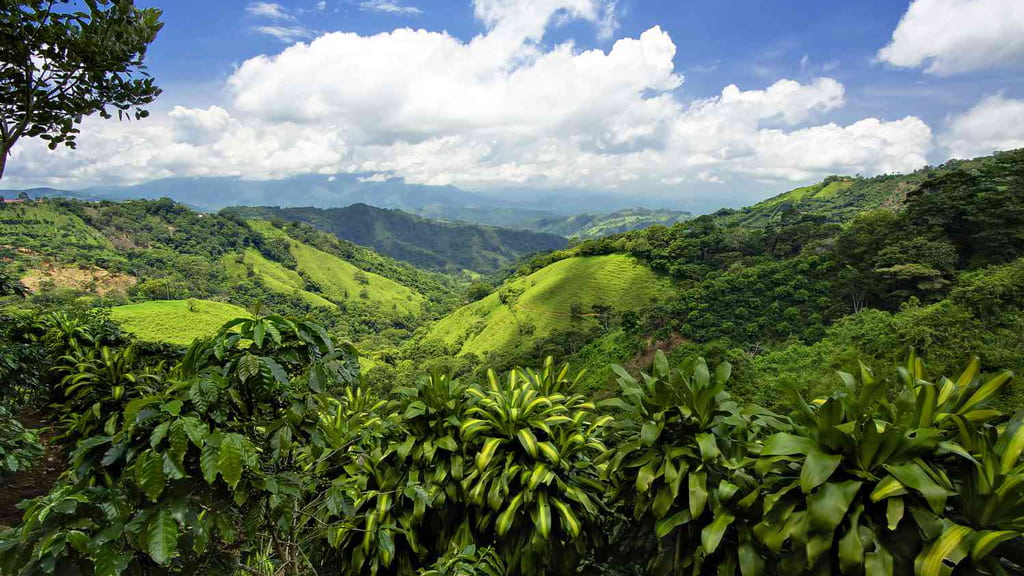Geography of Costa Rica

Introduction to Costa Rican Geography
Costa Rica, a small yet incredibly diverse country in Central America, is renowned for its rich geography. Its varied landscapes, from towering mountains to pristine beaches, have shaped the country’s culture, economy, and biodiversity.
Location and Borders
Costa Rica is located in Central America, bordered by Nicaragua to the north and Panama to the south. It is flanked by the Caribbean Sea to the east and the Pacific Ocean to the west, providing it with extensive coastlines on both sides.
Topography and Landforms
Mountain Ranges and Volcanoes
Costa Rica’s topography is dominated by its mountain ranges and volcanoes. The Cordillera Central and the Cordillera de Talamanca are the primary mountain ranges. The country is home to several active and dormant volcanoes, including Arenal, Poás, and Irazú, which are significant both geologically and touristically.
Valleys and Plains
In contrast to its rugged mountains, Costa Rica also features fertile valleys and plains. The Central Valley, where the capital city San José is located, is a key area for agriculture and human settlement. The northern lowlands and coastal plains are crucial for agriculture, particularly banana and pineapple cultivation.
Climate Zones
Costa Rica’s climate is primarily tropical, but it varies significantly across different regions.
Tropical Climate
Most of Costa Rica experiences a tropical climate, characterized by a distinct wet and dry season. The dry season typically runs from December to April, while the wet season spans from May to November.
Microclimates and Regional Variations
Due to its varied topography, Costa Rica has numerous microclimates. The coastal areas are hot and humid, while higher elevations in the mountains are cooler. The Caribbean side receives more rainfall year-round compared to the Pacific side.
Coastal Regions
Pacific Coast
The Pacific Coast of Costa Rica is known for its stunning beaches, surf spots, and diverse marine life. Regions like Guanacaste and the Nicoya Peninsula are popular tourist destinations, offering a mix of sandy beaches and rocky shorelines.
Caribbean Coast
The Caribbean Coast, though less developed than the Pacific, boasts lush rainforests and vibrant cultures. Tortuguero National Park, famous for its nesting sea turtles, is a major highlight.
Rivers and Lakes
Major Rivers
Costa Rica is traversed by numerous rivers, which are vital for its ecosystems and agriculture. Notable rivers include the San Juan River, which forms part of the border with Nicaragua, and the Tempisque River, crucial for the agriculture of the Guanacaste region.
Significant Lakes
Lake Arenal, situated at the base of Arenal Volcano, is the largest lake in Costa Rica. It is an important source of hydroelectric power and a hub for recreational activities.
Volcanic Activity
Active Volcanoes
Costa Rica’s volcanic activity is a defining feature of its geography. Active volcanoes like Arenal, Poás, and Irazú attract scientists and tourists alike. Their eruptions have shaped the landscape, creating fertile soils and geothermal activity.
Impact on the Landscape
Volcanic eruptions have created rich soils that support agriculture and diverse ecosystems. Hot springs and geothermal areas, such as those near Rincon de la Vieja Volcano, are popular tourist attractions.
National Parks and Protected Areas
Importance of Conservation
Costa Rica is a global leader in conservation, with over 25% of its land designated as protected areas. These efforts preserve its incredible biodiversity and provide opportunities for ecotourism.
Key National Parks
Some of the most famous national parks include Corcovado National Park, known for its biodiversity, and Manuel Antonio National Park, renowned for its beautiful beaches and diverse wildlife.
Flora and Fauna
Biodiversity Hotspots
Costa Rica’s varied climates and landscapes make it a biodiversity hotspot. Its rainforests, cloud forests, and coastal ecosystems support a vast array of plant and animal species.
Unique Species
The country is home to unique species such as the resplendent quetzal, three-toed sloth, and numerous types of orchids. Costa Rica’s commitment to conservation helps protect these species and their habitats.
Human Geography
Population Distribution
Costa Rica’s population is concentrated in the Central Valley, where the capital San José and other major cities like Alajuela and Heredia are located. Rural areas are more sparsely populated, with communities spread across the country’s diverse landscapes.
Major Cities and Urban Centers
San José is the largest city and the political, cultural, and economic hub of Costa Rica. Other significant urban centers include Liberia, a gateway to the Pacific Coast, and Limón, a major port city on the Caribbean Coast.
Agricultural Regions
Key Agricultural Products
Agriculture plays a vital role in Costa Rica’s economy. The country is a leading exporter of coffee, bananas, pineapples, and cocoa. The fertile soils and favorable climate make it an ideal location for cultivating these crops.
Impact on the Economy
Agricultural exports are a significant source of revenue for Costa Rica. Sustainable farming practices are increasingly important as the country balances economic growth with environmental conservation.
Indigenous Territories
Indigenous Communities and Their Lands
Indigenous communities, such as the Bribri, Cabécar, and Ngäbe-Buglé, inhabit various regions of Costa Rica. Their territories are rich in biodiversity and cultural heritage.
Cultural and Environmental Significance
These communities have a profound connection to the land, practicing traditional methods of agriculture and resource management that contribute to biodiversity conservation.
Tourism and Geography
Popular Tourist Destinations
Costa Rica’s diverse geography makes it a top destination for ecotourism. Popular sites include the beaches of Guanacaste, the rainforests of the Osa Peninsula, and the cloud forests of Monteverde.
Geographic Features Attracting Tourists
Tourists are drawn to Costa Rica’s volcanoes, national parks, and pristine coastlines. Activities such as hiking, birdwatching, surfing, and diving are popular due to the country’s varied landscapes.
Environmental Challenges
Deforestation and Land Use
Deforestation for agriculture and development poses a threat to Costa Rica’s forests. Efforts to combat deforestation include reforestation programs and sustainable land-use practices.
Climate Change and Natural Disasters
Climate change impacts Costa Rica through more frequent and severe weather events, such as hurricanes and heavy rainfall. These changes threaten ecosystems, agriculture, and infrastructure.
Sustainable Development
Efforts to Balance Development and Conservation
Costa Rica is committed to sustainable development, aiming to balance economic growth with environmental protection. Initiatives include promoting renewable energy, sustainable agriculture, and eco-friendly tourism.
Future Prospects
The future of Costa Rica’s geography and environment depends on continued efforts in conservation, sustainable practices, and climate adaptation. Collaboration between government, communities, and international partners is essential.
Conclusion
Costa Rica’s geography is a cornerstone of its identity, influencing its culture, economy, and biodiversity. Understanding and preserving this geographic wealth is crucial for the nation’s sustainable future.


